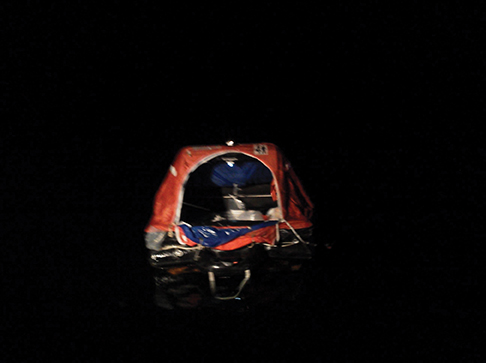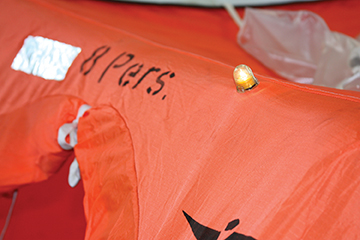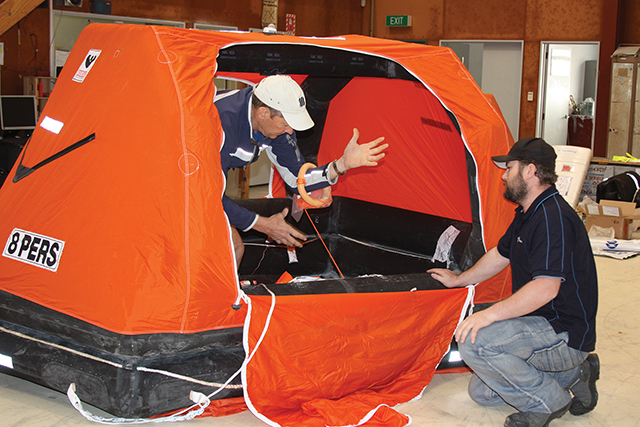A comprehensive guide to life rafts, their equipment, storage and deployment (published May 2014)
Life rafts are designed to keep the crew of a vessel alive for a short period of time after the vessel becomes uninhabitable due to fire or sinking. They provide a modest amount of shelter, equipment, hypothermia protection and a larger target for rescuers. In virtually all cases, a floating boat is a better choice than a life raft, so the decision to abandon ship must be made with great care after weighing the options.

TYPES OF RAFTS
Life rafts are classified in two ways: descriptive categories and international standards. The descriptive categories are loosely defined: one manufacturer may offer a raft in a lower category with some features from a higher category. The categories are frequently described as the following.
Rescue platforms are flat disks intended to keep survivors out of the water for short periods of time and increase their survival time by reducing hypothermia. They have virtually no gear, and may have little if any ballast system. In general, rescue platforms would more than likely be found in aircraft or commercial applications.
Coastal or near shore rafts generally have a single buoyancy tube, a manually or self-erecting canopy, modest ballast systems, frequently using “Icelandic” ballast bags, and raft essentials in the equipment pack. In recent years, very small life rafts intended for small offshore fishing boats have been developed. These can be quite small when in their containers, yet provide protection for two to six persons when inflated.
Offshore or ocean rafts have either a single large buoyancy tube or two stacked tubes, a large self-erecting canopy frequently with two arch supports, improved ballast systems, more gear in the equipment pack, a provision for keeping a watch with the canopy closed, and an insulated floor. In general, when a racing sailboat selects a raft for those races that require one, the raft will be in this category. Capacities vary from four persons to twelve.
SOLAS or Coast Guard approved rafts are similar to ocean category rafts but have much more equipment and may have insulated canopies for colder climates. These rafts may have a strong feature list, but it rapidly becomes a matter of how much one wants to spend and how much weight one can deal with compared to the incremental advantages. Some oceanic races may require SOLAS approved rafts.
There are several standards, old and new, which can define life rafts. Many life rafts were made to the older Offshore Racing Council or ORC standard based on a list of requirements for offshore racing found in the Offshore Racing Council requirements book, which has been replaced by the ISAF Special Regulations. Other standards include: IOS 9650, ISAF, SOLAS and U.S. Coast Guard.
Depending on the type of racing you are doing, you may have to buy or rent a raft that meets a very specific standard. Cruising sailors may not operate under such specific rules, and therefore may be able to use an existing raft regardless of its category until the useful life of the raft has been reached and it can no longer be repacked.
There are two types of life raft containers that you can choose between. A valise for the raft is made of coated fabric and fits over the raft like a tight duffle bag. While a valise-packed life raft is generally somewhat lighter and less expensive, it does not provide as much impact protection, UV protection, or water intrusion protection.
The other option is a canister, which will come in a plastic or fiberglass two-piece shell. The canisters may be sealed between the halves, or may have a shoebox-style lid that sheds water. Regardless, the canisters are not perfectly waterproof and will probably have drain holes in the bottom to allow condensation and other water to escape. The overriding rule is to mount valise rafts in dry locations, such as a cockpit locker, while a canister can be mounted on an exposed deck.
STOWAGE AND SERVICING
Raft manufacturers warranty most life rafts for 10 or 12 years, based on servicing according to their recommendations. In fact, a raft that is kept dry and is regularly repacked may last for 20 years or more until it is condemned by a factory-authorized service station. All of this depends to a large degree on whether the raft is damaged by water intrusion that leads to deterioration.
Many rafts are now vacuum-packed in sealed bags to prevent water from deteriorating the raft while in storage (presuming the bag remains intact.) Opinions vary as to the effectiveness of the vacuum packing, but virtually all experts believe that the quickest way to shorten the service life of a raft is to allow it to get wet and then leave the water in place. Fabric deterioration, metal corrosion, and seam failure can be the result.
Regardless of the type of raft, all rafts must be serviced according to the manufacturer’s recommendations by an authorized service station. And, if any raft is thought to have become “wet”, it should be serviced at the earliest practical time.
Although not common, there have been instances of inadequate servicing that have led to raft failures or raft theft (what was thought to be a raft turned out to be bricks and an old sail contained in a life raft canister). Since the only time you’re likely to need a life raft is when your life is threatened, you should “choose your raft repacker with the same care as you choose your family physician” in the words of the late Capt. John Bonds. An authorized repacker will invite you to see the raft when it’s in the process of being repacked so that you can see its features and understand what it contains, and what it does not. (For more on life raft repacking see page 46.)
LIFE RAFT EMERGENCY PACKS
Life rafts contain a distressingly modest amount of gear compared to what many raft survivors would have liked. This appears to be one of the great disconnects in expectations vs. reality, and for good reason. Most things in life are apparent and obvious: you can see and touch them and add to them if necessary. When you pack for a vacation, you know exactly what you’re carrying. A life raft emergency pack is different: it’s hidden from view, extremely space and cost constrained, and not visible until it’s too late to change it. In fact, life raft emergency packs can be added to when a life raft is being serviced, although the space is very tight, and some life raft repackers are not allowed to add items based on your specific type of raft and case.
The commonly supplied items are for the preservation of the raft, and not the crew. Common items include patch kits, leak stoppers (tapered rubber plugs that screw into holes in the fabric), raft repair clamps, topping-off pumps, bailers, paddles, sponges and overpressure valve plugs.
The next “level” up the survival chain generally includes some SOLAS flares (commonly three handheld and two rocket parachute flares), a fishing kit, a small medical kit, a signaling mirror, some sachets of water (125ml each, four per person), and seasickness pills. Take a look at the life raft manufacturer’s website or brochure to see exactly what’s included. Remember that many items will be due to a international standard as opposed to the whim of the life raft marketing team.
In Coast Guard and SOLAS rafts the inventory gets dramatically better, albeit heavier. More water, possibly some high calorie rations which do not require much water for digestion, a second drogue, and possibly some storage bags for all the gear.
What’s missing is vital: EPIRBs or other signaling electronics including a SART (Search And Rescue Transponder), a watermaker and a handheld VHF radio. And if you or anyone on your crew requires medicine on a regular basis to treat a chronic health condition, you had better carry it with you in the ditch bag because the life raft will surely not have it as standard equipment.
DITCH BAGS
If you want gear in your raft, and the raft doesn’t come with it, then you’ll want to make sure your ditch bag does. Five items that are a must include:
• An EPIRB (preferably) or a PLB.
• A watermaker like the Katadyn
Survivor 06.
• A waterproof handheld VHF radio
with extra batteries.
• Any prescription medicine that the
crew requires.
• A pair of cheap reading glasses.
The value of an EPIRB cannot be overemphasized. This single device will turn a life raft experience from a long, depressing test of survival, leading to the writing of a depressing book about how long it took to get rescued, to a breezy short story about the marvels of modern survival systems and the radios that make it all possible.
Ditch bags should float with all of the contents, should be of a bright color, have a lanyard so it can be attached to the life raft’s tether, and should be in a well known location on board the vessel. To hammer home the location of the life raft ditch bag, many skippers have their crews put their wallets and passports in the ditch bag along with the other gear. Not only is this helpful if you end up in a foreign country, but it ensures that everyone knows where it’s located.
STOWAGE OPTIONS
The life raft must be secured in such a way that it is accessible and able to be
launched when needed, but not subject to damage in rough seas. How you store a life raft will frequently be determined by the design of vessel you take to sea.
Many modern boats have purpose-built life raft lockers either in the sole of the cockpit, the transom or in a seat locker. This allows the raft to be easily reached, and also affords some protection to it over a long voyage. It also may allow you to select a valise life raft because of the protection from water intrusion.
If your boat lacks a life raft locker, the other likely mounting location will be on the coachroof or perhaps on a flat section of deck. This is where the life raft cradle comes in: a large stainless steel frame that will hold your raft securely until it’s needed. Many cruising boats will have a dedicated space for a cradle, but not all owners are so lucky. The life raft may occupy a space that is inconvenient for the crew, or possibly inconvenient for those who have to launch the life raft in deteriorating conditions.
Part and parcel of the on-deck cradle solution is the addition of a hydrostatic release. The hydrostatic release will automatically cut the attachment between the raft and the cradle, allowing a raft to float to the surface from a sinking vessel with no manual intervention. Cradles with hydrostatic releases will also have a manual release to allow the crew to remove the raft from the cradle without waiting for the vessel to sink.
You might be tempted to stow a life raft in a below-decks locker or living space, but before doing so, ask yourself: “In conditions where I might have to abandon ship, possibly after crew members have been injured, is it likely that I could remove the raft from its resting location and get it out the companionway to the cockpit, and from there to the rail?” If the answer is no, then you might consider a better on-deck solution. If you do opt for below-decks storage, be extraordinarily careful not to inflate the raft below decks. You can literally lift the deck off a boat’s hull with the force of an inflating life raft.
STABILITY
Beside the considerable amount of weight, and therefore stability, of the occupants of a life raft, there are two design elements that determine whether a life raft capsizes in heavy seas: drogues and ballast systems.
Drogues are small drag devices that have several beneficial effects on the life raft. They reduce the rate of drift, so the raft stays closer to the position where the boat was abandoned. They orient the raft relative to the wind, so that the door or other openings can be aligned with the wind (or protected from the wind). They keep the upwind edge of the life raft on the water so that wind doesn’t get under the raft and help in capsizing it. Drogues can also be pulled from the water if it makes sense to increase the drift rate of the raft. This might be desirable if a vessel founders upwind of a shipping route, for example.
Ballast systems vary by type of raft, but generally consist of several large “bags” which hang below the floor of the raft. These fill with water soon after the raft is deployed. In other cases, the ballast system is a single large fabric structure that fills with water. Ballast systems increase the stability of the raft by adding peripheral weight to the raft floor, increase the stability by blocking wind that might get under the raft to capsize it and reduce the rate of wind drift due to the increased drag.
LAUNCHING THE RAFT
Life rafts are vulnerable between the time they are inflated and when they are cut free from the mother ship. While durable when at sea, they are made from relatively thin fabric that can be cut by a damaged hull, a wind vane, part of a mast, or virtually any sharp object on the vessel.
Therefore, it makes sense to launch the raft on the leeward side of the vessel and to keep it on a short tether. But when should it be launched? Therein lies a problem. In many sea survival instances, sailors have launched their rafts prematurely, “just in case” things get worse quickly. The problem is two-fold. Rafts become increasingly attractive compared to the vessel that is sinking/burning/losing her rudder/losing her keel. The motivation to jump ship increases by the second. Rafts are also vulnerable, as discussed above. It becomes more urgent to abandon ship because the raft may fail if it is kept alongside the vessel.
These two issues have resulted in instances of crews abandoning vessels that are later found to be floating. And, as we’ve said before, a floating boat is almost always preferable to a life raft.

Chuck Hawley is a lifelong sailor, having sailed over 40,000 miles on a variety of power and sail vessels ranging from ultralight 24 footers to the 125’ catamaran PlayStation. Chuck is a nationally known speaker on marine safety, and is the chair of the US Sailing Safety at Sea Committee, as well as being a Powerboat Instructor for US Sailing. Chuck worked for West Marine for 30 years and held positions in marketing, merchandising, stores, and internet divisions. He is currently a marine industry consultant in strategic planning and product development. He lives in Santa Cruz, CA with his wife Susan and five daughters, and is a partner in an Alerion Express 38 Yawl.

















